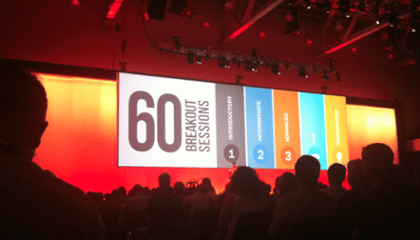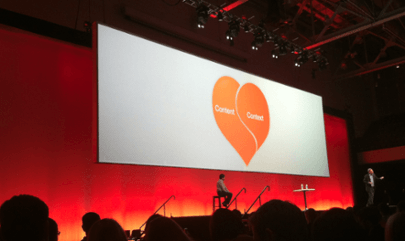Right now I’m in Boston, MA for Inbound 2012 (#INBOUND12). Inbound is THE conference of the year for (can you guess?) inbound marketing. It’s hosted and put on by HubSpot, and it’s open to VARs (Value Added Resellers), end users (HubSpot clients), and anyone who is into inbound marketing.
As a VAR, I arrived on Monday, a day early, for their VAR awards dinner. It was pretty much what I expected—great food, great people, but way too much talking. Since then, the event has been a whirlwind of meeting new people, seeing some great keynote speakers such as David Meerman Scott and Rand Fishkin, and sitting in on several very interesting learning sessions.
This was my first “industry conference.” Over the past four years, I’ve been busy building Blue Corona, and I always thought conferences were a waste of time/money—especially if you’re married with kids!

I was wrong.
It’s amazing how much more you can learn from engaging people in the “real world” versus just reading their tweets, blogs, and websites. Sometimes I think we spend so much time living in the virtual world of Facebook, Twitter, LinkedIn, etc. that we forget how valuable it is to exchange ideas face to face. So while this was my first conference, I don’t think it will be my last.
When Inbound12 is all said and done, I plan on writing a comprehensive post summarizing my thoughts and elaborating on everything I’ve learned over the past three days. Until then, here are some nuggets—thoughts and things I’ve picked up that I think are worth sharing:
Takeaway #1: A lot of inbound marketing companies are struggling are facing (significant) operational challenges.
Just like most business owners aren’t very good marketers, I’m afraid that an awful lot of inbound marketing experts aren’t the most adept business operators! Perhaps I should have been able to judge this based on the titles of the VAR tracks—“why you get fired,” “getting clients to pay you for strategy,” “how to create profitable service packages around inbound marketing,” etc.—the list goes on and on. You’d think that all these brilliant marketing minds would be able to use data to figure out why they get fired or how to generate warm enough leads that there’s no problem closing the deal.
I know that this statement has the potential to come across as arrogant—which is NOT my intention. I attended a bunch of them—something I wouldn’t have done if I weren’t at least intrigued—maybe I could be doing things better. I’m a new entrepreneur myself and I’m not ashamed to admit it! Although, I’ve learned dozens of significant business lessons from my partner Bob Perini, as well as from trial and error, I’ve still got much to learn.
That said, hearing the questions coming from some of the VAR training sessions makes me realize what an amazing job we’ve done building a business and a team at Blue Corona. I will return to our office with a renewed sense of motivation and vigor to keep up the momentum we already have! If you’re a client of Blue Corona, you should rest assured that you’re in good hands. If you find yourself wondering whether the grass would be greener with another online marketing company, I can assure you that the odds are high, it won’t be!
Brian Halligan and Dharmesh Shah are very smart AND incredibly cool
Their entrance to the kickoff keynote was nothing short of amazing. The delivery of both their speeches was great—a mix of low key, humorous, and filled with detailed insights. Today, I ran into Brian Halligan sitting near the back of one of the keynote speeches. We met eyes as we walked out and he randomly said, “Hey, how are you doing?” to which I replied, “fantastic—you guys are doing a great job.” A short interaction, yes, but he seemed genuinely down to earth—no ego—just a friendly guy on a mission. I ran into Dharmesh yesterday in the elevator—again, very friendly, very humble, another (seemingly) all-around good guy.
Rand Fishkin is taller (and thinner) than I expected
Rand, Whiteboard Fridays is not doing you any favors. You look, well, short. I’m a huge fan of SEOMoz—we’re a client and I love the community they’ve created as well as their story. Rand was on the top of my list of people to see. I lined up early for his keynote—so early that I had a chance to catch him making out with his wife just before entering the ballroom (I would have snapped a photo, but I didn’t want to be too creepy… this post is creepy enough).
Although he claims to be on the short side, Rand appears to be close to 6 feet tall (maybe he had on heel lifts?). Maybe he is really short and it’s just that he is so skinny that he looks tall? Seriously, he is so skinny that if he had turned sideways, he’d vanish like an SEO paying for links in a blog network.
On a serious note, his speech was awesome—all about irrational biases, but presented using the topic of dating. Creative and very entertaining.
Marcus Sheridan reminded me that the big picture is important
Marcus delivered one of the VAR tracks. The topic was how to create a culture of inbound marketing within your clients’ business. His enthusiasm for the subject makes you forget how many times he says things like “gosh darn” or “daggnabit!” He reminded me that to be successful, we have explain the big picture (the “why”) to our clients. Most of us (online marketing companies) are selling “programs,” but what we should be selling is a change in the culture of our clients’ organizations—from the CEO to the secretary.
Inbound marketing is complicated and it’s only going to get more complicated in the future
HubSpot makes a great set of tools, and with the announcement of HubSpot3, they just got much better. That said, inbound marketing is complicated and the complexity is growing exponentially with each passing quarter. I’m exploding with excitement because with complexity comes tremendous opportunity for teachers and ancillary service providers (me!).
More databases = more problems
In the unveiling of HubSpot3, Dharmesh talked about the problem marketers have with multiple (disconnected) databases. Most marketers and larger or more sophisticated companies have already discovered the power of database marketing. The problem is—they have too many damn databases and they are all disconnected from one another!
Think about it, your average marketing-centric company has a CRM (one database), an email platform (another database), a CMS (another database), a social media application (another database), etc., but NONE of them ever talk to each other!!
Why? Because they are all from different vendors. To connect them all and utilize the data, you’d a (bunch of) developers to glue the whole thing together—developers are expensive.

HubSpot3 could be a game-changer
The latest version of HubSpot is being dubbed HubSpot3. The two biggest advantages it offers are a single, unified marketing database and (with this) the ability to customize/personalize context based on any number of user parameters.
Wait, what?
Let me try to quickly explain… (recognize that I’m late for happy hour… err… a networking event!)
Creating web content is a great way to pull prospects to your website. I think most semi-sophisticated business owners understand this. That’s why you blog, that’s why you create a news section on your website, that’s why you create landing pages, etc. Google ranks web PAGES not web SITES. More pages on your website equals more ranking opportunities.
What most business owners DON’T understand is the importance context plays in the marketing funnel. According to Dharmesh, content is what brings people to your website, but it’s context that gets them to convert.
Think about your website and how it works. Now, go to Amazon.com. Compare the context of the content on your website to Amazon. If you’re like most business owners, you probably see a sharp divide—your content is static. Amazon’s content is DYNAMIC. What you see when you go to Amazon is customized and personalized for YOU.
The way Amazon accomplishes this is by CONNECTING their front end content database with their backend analytics database. With HubSpot3, small businesses will be able to do almost exactly the same thing! Imagine having ALL your contacts in a single database. Imagine being able to see their every online action—which pages of your website they view, which of your marketing emails they open, which of your tweets they retweet, etc. Imagine being able to show their CUSTOM calls to action based on their past actions.
All of this (in theory) will be possible in HubSpot3!
Please come back late next week for a more organized post detailing what I’ve learned at Inbound 2012 (and please forgive any typos in the post above—I’ve been running from event to event all day long and I’m late for one now!).











